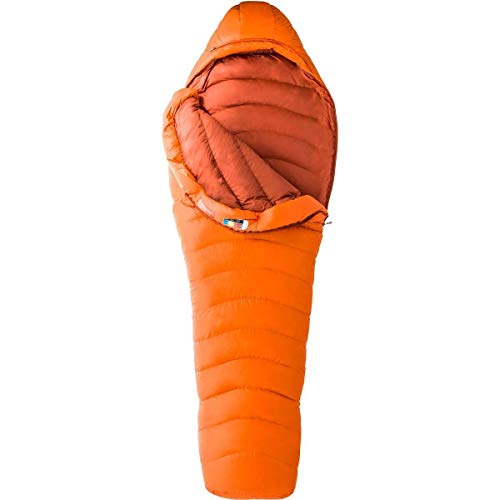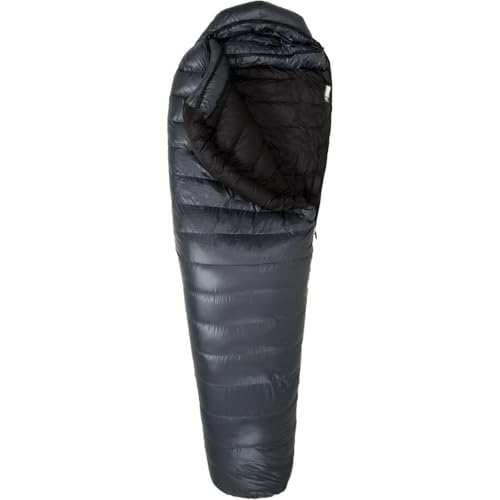When the temperature plummets and the wind howls outside your tent, your entire backpacking trip hinges on one crucial piece of gear: your sleeping bag. A bag that’s not up to the task can turn an adventure into a miserable, shivering ordeal. The right cold-weather sleeping bag is more than just insulation; it’s your portable shelter, your warmth sanctuary, and the key to waking up refreshed and ready for the trail ahead.
Selecting the perfect bag involves balancing critical factors like temperature rating, weight, packability, and comfort features. From ultralight models for fast-and-light missions to expedition-grade systems for the harshest conditions, the market offers a solution for every winter warrior. This roundup cuts through the noise to present the top performers that will keep you warm and secure when the mercury drops.
The Best Cold Weather Sleeping Bags for Backpacking
- MARMOT Lithium
- Western Mountaineering Kodiak LZ Microfiber
- Sleeping Bags for Adults Backpacking Ultralight
- NEMO Disco 15 Degree Men’s Sleeping Bag
- Marmot Never Summer -20 Degree Down Sleeping Bag
- The North Face Inferno -20F Sleeping Bag
- REI Co-op Magma 15 Sleeping Bag
- Big Agnes Torchlight 20 Women’s Sleeping Bag
MARMOT Lithium

The MARMOT Lithium is a benchmark for high-performance, cold-weather backpacking. Engineered with premium down insulation, it offers an exceptional warmth-to-weight ratio, making it a favorite among alpinists and winter backpackers who need reliable warmth without excessive bulk. Its carefully designed baffle system prevents cold spots and maximizes thermal efficiency throughout the night.
Durability and weather resistance are key, thanks to a high-quality shell fabric that shields the down from light moisture. The bag includes a snug-fitting hood and a draft collar to seal in warmth, while the robust zipper slide smoothly without snagging. For those facing frigid conditions where every ounce counts, the Lithium represents a top-tier balance of protection and packability.
Western Mountaineering Kodiak LZ Microfiber

For expedition-level cold, the Western Mountaineering Kodiak LZ stands as a fortress of warmth. It features a generous cut with 5 1/4 inch spacing and continuous baffles, allowing for optimal down loft and preventing heat loss. With a 66-inch shoulder girth and a 41-inch foot girth, it provides ample room for movement without sacrificing thermal efficiency, which is crucial for long nights in extreme conditions.
The full down collar is a highlight, creating a secure seal around your neck to block drafts completely. Crafted with meticulous attention to detail and high-fill-power down, this bag is built for mountaineers and polar explorers who demand the utmost reliability. The durable yet lightweight microfiber shell offers a great balance of protection and breathability for multi-season alpine use.
Sleeping Bags for Adults Backpacking Ultralight

This versatile sleeping bag offers a practical solution for three-season backpacking where budget is a key consideration. Its design focuses on user comfort, featuring a roomy interior that can accommodate campers up to 5 feet 11 inches tall. The hollow cotton fill and polyester lining provide a skin-friendly feel, making for a comfortable night’s sleep in cool conditions.
Thoughtful design elements enhance its functionality, including a drawstring hood to keep your head warm and a unique zipper at the foot for ventilation control. The 190T nylon outer shell provides a degree of water resistance, adding a layer of protection against damp environments. It’s a solid choice for those who need a reliable, all-around bag for general camping and fair-weather backpacking trips.
NEMO Disco 15 Degree Men’s Sleeping Bag
The NEMO Disco redefines sleeping comfort with its unique “spoon” shape, which provides extra room at the elbows and knees for side sleepers to move naturally. This design eliminates the constricted feeling of a traditional mummy bag while maintaining thermal efficiency through strategic gill-style vents that allow for precise temperature regulation. It’s an ideal bag for those who feel confined in standard mummy bags.
Beyond its shape, the Disco includes a integrated pillow pocket to keep your inflatable pillow in place all night. The waterproof footbox and top-quality down insulation ensure you stay dry and warm. If you prioritize freedom of movement and personalized comfort on your cold-weather trips, the NEMO Disco offers a refreshing alternative.
Marmot Never Summer -20 Degree Down Sleeping Bag
Built for the deepest cold, the Marmot Never Summer is a serious winter fortress. Its -20 degree Fahrenheit rating makes it suitable for high-altitude mountaineering and winter camping in the most severe conditions. The bag utilizes high-loft down and a robust baffle system to create a thick layer of insulation that stands up to extreme temperatures.
Features like a draft tube behind the full-length zipper, a insulated draft collar, and a close-fitting hood work in concert to eliminate cold air intrusion. The materials are selected for maximum durability and longevity, even with heavy use. For expeditions where failure is not an option, the Never Summer provides the confidence and warmth needed for a safe and restful night.
The North Face Inferno -20F Sleeping Bag
The North Face Inferno series represents the pinnacle of the brand’s thermal technology, designed for the world’s coldest environments. It incorporates high-fill-power down and proprietary Heatseeker™ Eco insulation in key areas to provide exceptional warmth without excessive weight. The bag’s cut is engineered to minimize dead air space while still allowing for essential movement.
Attention to detail is evident in its welded seams, water-resistant finish, and the anatomically shaped footbox that reduces pressure on your feet. The Inferno is a product of extensive research and testing, making it a reliable choice for serious adventurers facing predictable and unpredictable severe winter weather.
REI Co-op Magma 15 Sleeping Bag
The REI Co-op Magma 15 delivers outstanding value by offering premium features at a more accessible price point. It uses high-quality, responsibly sourced down to achieve an impressive warmth-to-weight ratio, competing with bags that cost significantly more. Its streamlined mummy shape is designed to maximize warmth without feeling overly restrictive.
It includes practical details like a contoured hood, a draft collar, and a trapezoidal baffle at the foot to reduce weight while keeping toes warm. The shell fabric has a durable water-repellent (DWR) finish to resist light moisture. For backpackers seeking top-tier performance from a trusted cooperative brand, the Magma 15 is an excellent and reliable investment.
Big Agnes Torchlight 20 Women’s Sleeping Bag
Specifically designed for women, the Big Agnes Torchlight 20 addresses key differences in physiology for better warmth and comfort. It features additional insulation in the footbox and torso, areas where women typically feel colder. The bag also utilizes a narrower cut at the shoulders and a wider cut at the hips for a more natural and comfortable fit.
A standout feature is the integrated sleeping pad sleeve on the back, which securely holds your pad in place. This system eliminates the cold spots caused by rolling off an insulated pad and allows for more restful sleep. For female backpackers seeking a bag tailored to their shape and warmth needs, the Torchlight offers a thoughtful and effective solution.
Buying Guide: How to Pick a Cold Weather Sleeping Bag for Backpacking
Choosing the right cold weather sleeping bag for backpacking is a balance between warmth, weight, and packability. Getting it wrong can mean a miserable, shivering night. I always start by looking at the temperature rating. This is the most critical spec. Look for an EN/ISO rating, which is a standardized test. The number you see, like -10°C or 15°F, is typically the “Lower Limit” rating—the temperature at which a standard man can sleep for eight hours without waking. If you’re a cold sleeper like me, you’ll want a bag rated for temperatures 10-15 degrees Fahrenheit colder than what you actually expect.
Next up is insulation. For cold weather, you’re usually choosing between high-quality down or synthetic. Down, like 800-fill or higher, is the winner for its incredible warmth-to-weight ratio and superior packability. The main drawback is that it loses its insulating power when wet. Synthetic insulation, on the other hand, is heavier and bulkier but will keep you warm even if it gets damp. For dry, cold climates, I always lean towards down. If I expect wet conditions, like in a humid fall or winter, I seriously consider a synthetic option.
The shape of the bag matters more than you think. Mummy bags are the standard for cold weather backpacking. Their snug fit minimizes the amount of air your body has to heat, making them incredibly efficient. They save weight and pack space, which is a huge plus when every ounce counts. Rectangular bags are roomy but create a lot of dead air space, making them less suitable for true cold-weather use.
Don’t overlook the features. A well-designed hood that cinches down around your face is a game-changer for heat retention. A draft tube behind the zipper is essential to stop cold spots. Look for a draft collar—a insulated tube around the neck—that acts like a scarf. For the 8 best cold weather sleeping bags for backpacking in 2025, I’ve focused on models that excel in all these areas, giving you a list of reliable shelters for your next winter adventure.
FAQ
What temperature rating do I really need for winter backpacking?
This depends on the specific conditions and whether you are a warm or cold sleeper. As a general rule, I choose a bag with a lower limit rating at least 10°F (5-6°C) colder than the lowest temperature I expect to encounter. If the forecast says 20°F, I want a 10°F bag. This gives me a safety margin for unexpected weather drops and for the fact that I tend to get cold. Always err on the side of a warmer bag.
Is a down or synthetic sleeping bag better for cold, wet conditions?
Historically, synthetic has been the safer choice for wet conditions because it retains its insulation when damp. However, today’s hydrophobic down treatments have significantly closed the gap. Treated down resists moisture much better than standard down. For most mixed or potentially wet winter trips, a high-quality hydrophobic down bag is my personal choice because of its weight and packability advantages. For consistently soggy environments, a premium synthetic bag is still a very solid and reliable option.
How do I keep my sleeping bag dry in my backpack?
I always use a waterproof pack liner, which is a large, durable bag that goes inside my backpack. Everything that must stay dry, especially my sleeping bag, goes inside this liner. I then compress the sleeping bag with a compression sack before placing it in the liner. Some people prefer to just stuff their loose sleeping bag into the liner at the bottom of the pack, using it as a filler, which can be gentler on the insulation. Either way, the waterproof liner is your first and best line of defense.
Should I get a men’s or women’s specific sleeping bag?
Women’s specific sleeping bags are designed with different proportions—they are often narrower at the shoulders, wider at the hips, and shorter in length. They also typically have more insulation in the torso and foot box areas, as women generally lose heat faster in their extremities. If you find a standard bag is too roomy in some places or you always have cold feet, a women’s model could be a much warmer and more comfortable fit.
How much should a good cold weather backpacking sleeping bag weigh?
Weight is a major factor, but it’s tied directly to the temperature rating. For a reliable 3-season bag (down to about 20°F), you can find great options under 3 pounds. For true winter conditions, like a 0°F to -20°F rating, you should expect a weight between 3 and 5 pounds. The lightest bags use premium high-fill-power down and minimalist features, but they come with a higher price tag. When looking at the 8 best cold weather sleeping bags for backpacking in 2025, I’ve tried to highlight options that strike a smart balance between weight, warmth, and cost.